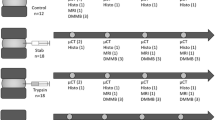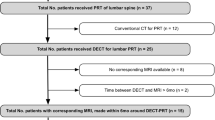Abstract
Purpose
Inflammation plays a key role in the progression of intervertebral disk (IVD) herniation and associated low back pain. However, real-time spatial diagnosis of inflammation associated with acute disk herniation has not been investigated. We sought to detect local neutrophil and macrophage infiltration near disk herniation via the formyl peptide receptor 1 (FPR1)-mediated molecular imaging in a disk puncture mouse model to elucidate pathophysiological process of disk herniation.
Procedures
Disk herniation was induced in mouse with an established needle puncture procedure. Degenerative change of disk and infiltration of neutrophils and macrophages were detected with Safranin-O, hematoxylin and eosin (H&E), and immunohistochemical staining after injury. FPR1-specific imaging probes cFLFLF-PEG-Cy7 and [99mTc]HYNIC-PEG-cFLFLF were administered systemically to sham and disk injury mice. Leukocyte infiltration was tracked by in vivo near-infrared fluorescence (NIRF) and single-photon emission tomography (SPECT) imaging. The peptide-receptor binding specificity was further investigated with FPR1−/− mice via ex vivo NIRF scan and in vitro binding assays.
Results
Safranin-O staining exhibited disorganized disk structure and loss of proteoglycan after puncture. Massive inflammatory cells were observed in the anterior region of punctured annulus in the injury group. The majority of neutrophils were detected at 1 through 3 days, while infiltration of macrophages appeared the most at 7 days after injury. NIRF and SPECT images revealed preferential accumulation of cFLFLF probes in herniation site in wild-type mice but not in FPR1−/− mice. Binding of the cFLFLF peptide to FPR1 was also observed in RAW 267.4 cells and macrophages isolated from wild-type mice, whereas much less signal was observed in macrophages from FPR1−/− mice. The presence of macrophage infiltration was also detected in human-herniated disk samples by immunohistochemistry.
Conclusion
For the first time, leukocyte infiltration around acute disk herniation site was detected directly and non-invasively in a timely fashion using FPR1-targeted molecular imaging modalities. Such functional imaging of disk herniation via infiltrated leukocytes would advance the understanding of etiology and facilitate drug delivery and treatment monitoring of disk herniation.






Similar content being viewed by others
References
Andersson GBJ (1999) Epidemiological features of chronic low-back pain. Lancet 354:581–585
Katz JN (2006) Lumbar disc disorders and low-back pain: socioeconomic factors and consequences. J Bone Joint Surg 88:21–24
Pillastrini P, Gardenghi I, Bonetti F et al (2012) An updated overview of clinical guidelines for chronic low back pain management in primary care. Joint Bone Spine 79:176–185
Molinos M, Almeida CR, Caldeira J et al (2015) Inflammation in intervertebral disc degeneration and regeneration. J Royal Soc Interface 12:20150429
Risbud MV, Shapiro IM (2014) Role of cytokines in intervertebral disc degeneration: pain and disc-content. Nat Rev Rheumatol 10:44–56
Bufe B, Schumann T, Kappl R et al (2015) Recognition of bacterial signal peptides by mammalian formyl peptide receptors: a new mechanism for sensing pathogens. J Biol Chem 290:7369–7387
Chen J, Cheng H, Dong Q et al (2015) [99mTc]cFLFLF for early diagnosis and therapeutic evaluation in a rat model of acute osteomyelitis. Mol Imaging Biol 17:337–344
Xiao L, Zhang Y, Liu Z et al (2010) Synthesis of the cyanine 7 labeled neutrophil-specific agents for noninvasive near infrared fluorescence imaging. Bioorg Med Chem Lett 20:3515–3517
Zhang Y, Xiao L, Chordia MD et al (2010) Neutrophil targeting heterobivalent SPECT imaging probe: cFLFLF-PEG-TKPPR-99mTc. Bioconjug Chem 21:1788–1793
Jin L, Liu Q, Scott P et al (2014) Annulus fibrosus cell characteristics are a potential source of intervertebral disc pathogenesis. PLoS One 9:e96519
Xiao L, Zhang Y, Berr SS et al (2012) A novel near-infrared fluorescence imaging probe for in vivo neutrophil tracking. Mol Imaging 11:372–382
Ray A, Dittel BN (2010) Isolation of mouse peritoneal cavity cells. doi: 10.3791/1488
Jin L, Wan Y, Shimer AL, Shen FH, Li XJ (2012) Intervertebral disk-like biphasic scaffold—demineralized bone matrix cylinder and poly(polycaprolactone triol malate)—for interbody spine fusion. J Tissue Eng. doi:10.1177/2041731412454420
Liu Q, Jin L, Shen FH, Balian G, Li XJ (2013) Fullerol nanoparticles suppress inflammatory response and adipogenesis of vertebral bone marrow stromal cells—a potential novel treatment for intervertebral disc degeneration. Spine J 13:1571–1580
Woertgen CMD, Rothoerl RDMD, Brawanski AMDP (2000) Influence of macrophage infiltration of herniated lumbar disc tissue on outcome after lumbar disc surgery. Spine 25:871–875
Doita MMD, Kanatani TMD, Harada TMD, Mizuno KMD (1996) Immunohistologic study of the ruptured intervertebral disc of the lumbar spine. Spine 21:235–241
Rothoerl RD, Woertgen C, Brawanski A (2002) Pain resolution after lumbar disc surgery is influenced by macrophage tissue infiltration. A prospective consecutive study on 177 patients. J Clin Neurosci 9:633–636
Hamamoto HMD, Miyamoto HMD, Doita MMD et al (2012) Capability of nondegenerated and degenerated discs in producing inflammatory agents with or without macrophage interaction. Spine 37:161–167
Takada T, Nishida K, Maeno K et al (2012) Intervertebral disc and macrophage interaction induces mechanical hyperalgesia and cytokine production in a herniated disc model in rats. Arthritis Rheum 64:2601–2610
Locke LW, Chordia MD, Zhang Y et al (2009) A novel neutrophil-specific PET imaging agent: cFLFLFK-PEG-64Cu. J Nucl Med 50:790–797
Gao J-L, Lee EJ, Murphy PM (1999) Impaired antibacterial host defense in mice lacking the N-formylpeptide receptor. J Exp Med 189:657–662
Liang H, Ma S-Y, Feng G, Shen FH, Joshua Li X (2010) Therapeutic effects of adenovirus-mediated growth and differentiation factor-5 in a mice disc degeneration model induced by annulus needle puncture. Spine J 10:32–41
Martin JT, Gorth DJ, Beattie EE et al (2013) Needle puncture injury causes acute and long-term mechanical deficiency in a mouse model of intervertebral disc degeneration. J Orthop Res 31:1276–1282
Michalek AJ, Buckley MR, Bonassar LJ, Cohen I, Iatridis JC (2010) The effects of needle puncture injury on microscale shear strain in the intervertebral disc annulus fibrosus. Spine J 10:1098–1105
Walter BA, Korecki CL, Purmessur D et al (2011) Complex loading affects intervertebral disc mechanics and biology. Osteoarth. Cartilage 19:1011–1018
Yurube T, Hirata H, Kakutani K et al (2014) Notochordal cell disappearance and modes of apoptotic cell death in a rat tail static compression-induced disc degeneration model. Arthritis Res Ther 16:R31
Ding F, Shao Z-W, Yang S-H et al (2012) Role of mitochondrial pathway in compression-induced apoptosis of nucleus pulposus cells. Apoptosis 17:579–590
Acknowledgements
The current study was funded by NIH grants NIAMS R21AR057512 and RO1AR064792.
Author information
Authors and Affiliations
Corresponding author
Ethics declarations
Conflict of Interest
The authors declare that they have no conflict of interest.
Electronic supplementary material
ESM 1
(PDF 457 kb)
Rights and permissions
About this article
Cite this article
Xiao, L., Ding, M., Zhang, Y. et al. A Novel Modality for Functional Imaging in Acute Intervertebral Disk Herniation via Tracking Leukocyte Infiltration. Mol Imaging Biol 19, 703–713 (2017). https://doi.org/10.1007/s11307-016-1038-6
Published:
Issue Date:
DOI: https://doi.org/10.1007/s11307-016-1038-6




